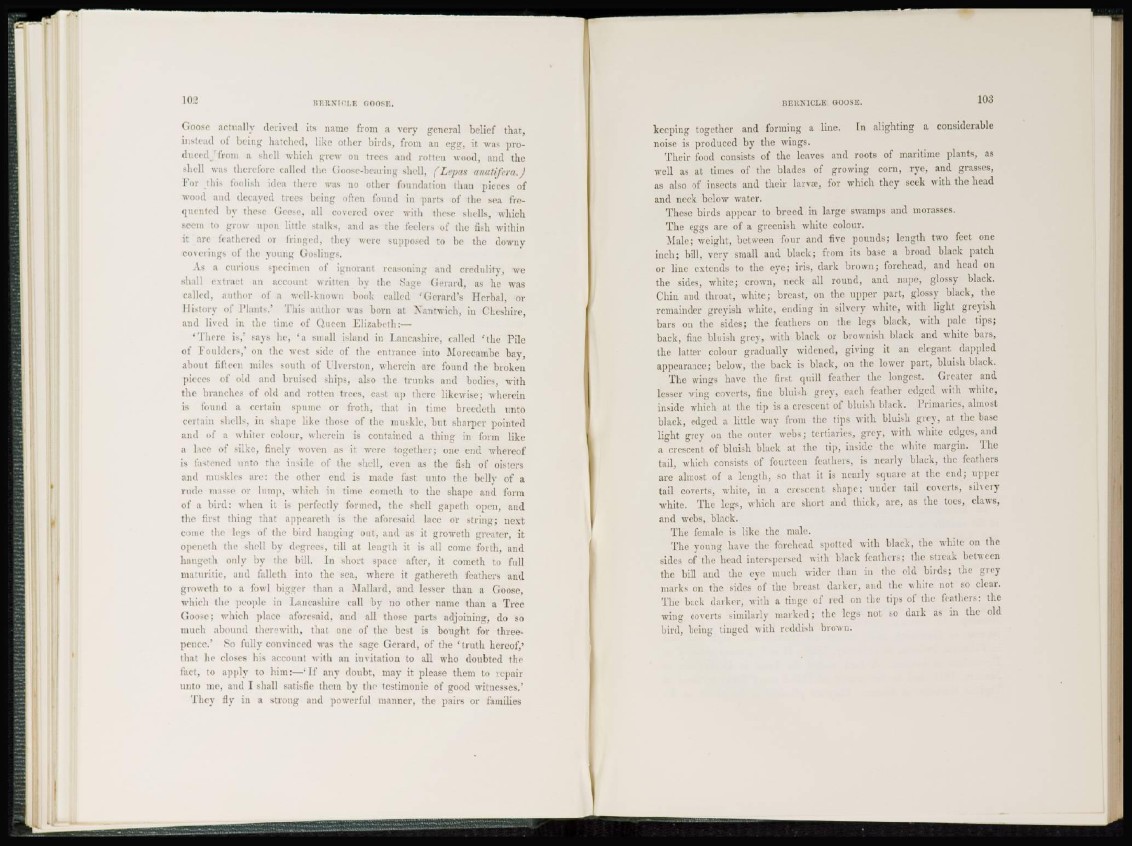
102 HI'. 11X11" 1,1-', GOOSE,
Goose actually derived its name from a very general belief that,
instead of being hatched, Hke other birds, from an egg, it was produced
from a shell which grew on trees and rotten wood, and the
shell was therefore called the Goose-bearing shell, (Lcpas anutifrra.J
For tins foolish idea there was no other foundation than pieces of
wood and decayed trees being often found in parts of the sea frequented
by these Geese, all covered over with these shells, which
seem to grow upon little stalks, and as the feelers of the fish within
it arc feathered or fringed, they were supposed to be the dowuy
coverings of the young Goslings.
As a curious specimen of ignorant reasoning and credulity, we
shall extract an account written by the Sage Gerard, as he was
called, author of a well-known book called 'Gerard's Herbal, or
History of Plants.' This author was born at Nantwich, in Cheshire,
and lived in the time of Queen Elisabeth:—
' T h e r e is," says he, "a small island in Lancashire, called ' t h e Pile
of Foulders,' on the west side of the entrance into Morecambe bay,
about fifteen miles south of Diversion, wherein are found the broken
pieces of old and bruised ships, also the trunks ami bodies, with
the branches of old and rotten trees, cast up there likewise; wherein
is found u certain spume or froth, that in time breedeth unto
certain shells, in shape like those of the muskle, but sharper pointed
and of a whiter colour, wherein is contained a thing in form like
a lace of silkc, finely woven as it were together; one end whereof
is fastened unto the inside of the shell, even as the fish of oisters
and musklcs are: the other end is made fast unto the belly of a
rude masse or lump, which in time cometh to the shape and form
of a bird: when it is perfectly formed, the shell gapeth open, and
the first thing that appeareth is the aforesaid lace or string; next
come the legs of the bird hanging out, and as it groweth greater, it
opencth the shell by degrees, till at length it is all come forth, and
hangeth only bv the bill. In short space after, it cometh to full
maturitie, and falleth into the sea, where it gathereth feathers and
groweth to a fowl bigger than a Mallard, and lesser than a Goose,
which the people in Lancashire call by no other name than a Tree
Goose; which place aforesaid, and all those parts adjoining, do so
much abound therewith, that one of the best is bought for threepence.*
So fully convinced was the sage Gerard, of the ' t r u t h hereof,'
that lie closes his account with an invitation to all who doubted the
fact, to apply to h i m : — ' I f any doubt, may it please them to repair
unto me, and I shall satisfie them by the testimonie of good witnesses.'
They fly in a strong and powerful manner, the pairs or families
R E U X I C L E GOOSE. 10S
keeping together and forming a line. In alighting a considerable
noise is produced by the wings.
Their food consists of the leaves and roots of maritime plants, as
well as at times of the blades of growing corn, rye, a nd grasses,
as also of insects and their larvae, for which they seek with the head
and neck below water.
These birds appear to b r e e d in large swamps and morasses.
The eggs are of a greenish wdiite colour.
Male; weight, between four and five pounds; length two feet one
inch; bill, very small and black; from its base a broad black patch
or hue extends to the eye; iris, dark brown; forehead, and head on
the sides, white; crown, neck all round, and nape, glossy black.
Chiu and throat, white; breast, on the upper part, glossy black, the
remainder greyish white, ending in silvery white, with light greyish
bars on the sides; the feathers on the legs black, with pale tips;
back, fine bluish grey, with black or brownish black and white bars,
the latter colour gradually widened, giving it an elegant dappled
appearance; below, the back is black, on the lower part, bluish black.
The wings have the first quill feather the longest. Greater and
lesser wing coverts, fine bluish grey, each feather edged with white,
inside which at the t ip is a crescent of bluish black. Primaries, almost
black, edged a little way from the tips with bluish grey, at the base
light grey on the outer webs; tertiaries, grey, with white edges, and
a crescent of bluish black at the tip, inside the white margin. The
tail, which consists of fourteen feathers, is nearly black, the feathers
are almost of a length, so that it is nearly square at the end; upper
tail coverts, wdiite, iu a crescent shape; under tail coverts, sill cry
white. The legs, which are short and thick, are, as the toes, claws,
and webs, black.
The female is like the male.
The young have the forehead spotted with black, the white on the
sides of the head interspersed with black feathers; the streak between
the bill and the eye much wider than in the old birds; the grey
marks on t h e sides of the breast darker, and the white not so clear.
The back darker, with a tinge of red on the tips cf the feathers: the
wing coverts similarly marked; the legs not to dark as in the old
bird, being tinged with reddish brown.